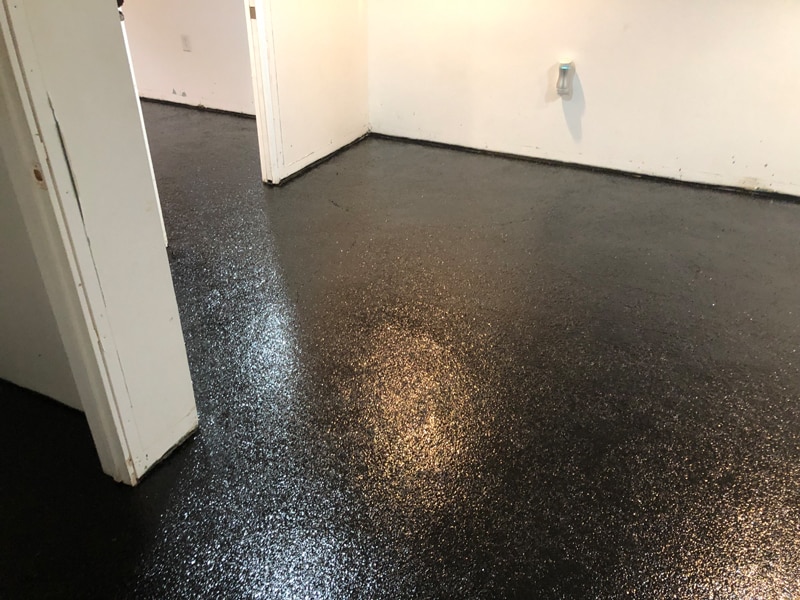What are the Disadvantages of Polyaspartic Coatings?
June 25th, 2024 | 3 min. read

If you're considering a new floor coating, you've likely come across polyaspartic coatings. Maybe you're a homeowner looking to upgrade your garage floor, or perhaps you run a business and need a durable, attractive finish for your showroom. Regardless, you've probably heard a lot of good things about polyaspartic coatings. But let's face it—no product is perfect, and you're right to want the full picture before making a decision.
At Floor Shield, we've been in the coating business for years, and we get it. You're looking for the best option for your floors, and that means understanding both the strengths and the weaknesses of each product. So, what are the disadvantages of polyaspartic coatings? We're here to break it down for you, so you can make an informed choice.
In this article, we'll explore the main drawbacks of polyaspartic coatings, including leveling issues, rapid drying times, thickness limitations, cost considerations, wear and tear, and application challenges. By the end, you'll have a clear understanding of whether polyaspartic coatings are right for you—or if another option might be better suited to your needs.
Self-Leveling Challenges
One of the primary drawbacks of polyaspartic coatings is that they don't level out as well as other coatings like epoxy. You might be wondering, "Why does this matter?" Imagine applying a coating and seeing bumps or uneven areas as it dries—it's not what you want for a smooth, professional finish.
Polyaspartic coatings dry quickly, which is both a blessing and a curse. On one hand, the rapid drying time means you can get back to using your space sooner. On the other hand, it doesn't allow the coating enough time to settle and level out perfectly. This can result in a less smooth surface compared to epoxy, which has a longer drying time and therefore levels out better.
Rapid Drying Time
Speaking of quick drying, while this is great for reducing downtime, it can pose challenges during application. Polyaspartic coatings dry so fast that if you're not careful, you could end up with an uneven finish. This requires the installer to work quickly and efficiently, which isn't always easy.
Consider this scenario: you're a business owner, and you want to coat your showroom floor over the weekend. With polyaspartic coatings, you can apply the coating and be ready to open on Monday. However, the quick drying time means any mistakes made during application are harder to correct. It’s a trade-off between speed and perfection.
Thickness Limitations
Another disadvantage is the thickness of the coating. Polyaspartic coatings are thinner than epoxy coatings. While they can be applied up to about 40 mils thick, epoxies can go even thicker. Why does this matter? Thicker coatings tend to handle moisture vapor better and offer more substantial protection against wear and tear.
Let's say you're dealing with a garage floor that occasionally has moisture issues. A thicker epoxy coating might be better at resisting that moisture over time. Polyaspartic coatings, being thinner, might not offer the same level of resistance, even though they are molecularly strong.
Cost Considerations
When it comes to cost, polyaspartic coatings can be more expensive than other options like epoxy or polyurea. The price of polyaspartic coatings typically ranges from $7 to $9 per square foot. While prices have been leveling out recently, with epoxy and polyurea also becoming more expensive, polyaspartic coatings are still on the higher end.
Here’s a story to illustrate: A homeowner gets quotes from multiple contractors for their garage floor. One offers an epoxy coating at $4 per square foot, while another suggests polyaspartic at $7 per square foot. The homeowner needs to weigh the benefits of each option against their budget, knowing that polyaspartic might offer quicker return to service but at a higher initial cost.
Wear and Tear
Polyaspartic coatings are harder than epoxy, which means they wear down more slowly. However, because they are applied thinner, there's less material to wear through. This means that while the surface is durable, it might not last as long under heavy use compared to a thicker epoxy coating.
Think about a busy commercial kitchen floor. It's going to see a lot of traffic, spills, and cleaning. The harder polyaspartic coating might resist scratches and stains better initially, but over time, the thinner application could wear down faster than a thicker epoxy layer.
Application Challenges
Finally, polyaspartic coatings require professional installation to get the best results. The rapid drying time and need for precise application mean that DIY projects can be tricky and often lead to subpar results. This isn't necessarily a disadvantage if you plan to hire professionals, but it's something to consider if you were thinking about tackling the project yourself.
Picture this: a DIY enthusiast decides to apply a polyaspartic coating to their garage floor. They quickly realize that the fast drying time doesn't leave much room for error. Despite their best efforts, they end up with an uneven finish and wish they had opted for professional installation.
Conclusion
At Floor Shield, we believe in giving you all the information you need to make the best decision for your floors. While polyaspartic coatings offer many benefits, including quick drying times and durability, they aren't perfect for every situation. The leveling issues, thickness limitations, and higher cost are important factors to consider.
We understand that Floor Shield might not be the right choice for everyone. If you need a thicker coating or are working within a tight budget, epoxy might be a better option. However, if you value quick return to service and superior durability, polyaspartic could be the perfect fit for your needs.
Ultimately, the best coating for your floor depends on your specific circumstances and priorities. We hope this article has helped clarify the disadvantages of polyaspartic coatings, so you can make an informed choice.
If you’d like a free, no-obligation quote for Floor Shield, you can fill out the form below.
